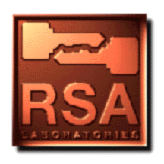

Quantum cryptography [BBB92]
[Bra93]
is a method for secure key exchange over an insecure channel based on the
nature of photons. Photons have a polarization, which can be measured
in any basis, where a basis consists of two directions orthogonal to each
other, as shown in Figure 12. If a photon's polarization is read in the
same basis twice,

Figure 12. Bases
the polarization will be read correctly and will remain unchanged. If it is read in two different bases, a random answer will be obtained in the second basis, and the polarization in the initial basis will be changed randomly, as shown in Figure 13.

Figure 13. Polarization readings
The following protocol can be used by Alice and Bob to exchange secret keys.
Quantum cryptography has a special defense against eavesdropping: If an enemy measures the photons during transmission, he will use the wrong basis half the time, and thus will change some of the polarizations. That will result in Alice and Bob having different values for their secret keys. As a check, they can exchange some random bits of their key using an authenticated channel. They will therefore detect the presence of eavesdropping, and can start the protocol over.
There has been experimental work in developing such systems by IBM and British Telecom. For information on quantum computing (which is quite different from quantum cryptography), see Question 109.